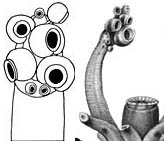Lepidoteuthid families
Michael Vecchione and Richard E. Young- Lepidoteuthidae Pfeffer 1912
- Octopoteuthidae Berry 1912
- Pholidoteuthidae Adam, 1950
Introduction
This group contains three families that appear quite different from one another yet they are grouped together because each shows strong similarities in certain features to one of the other families. These are moderate to large squid that live in midwaters when young and probably associate with the ocean floor as adults.
Characteristics
- Arms
- Suckers or hooks in two series.
- Hectocotylization absent.
- Buccal crown
- Buccal connectives attach to ventral borders of arms IV.
- Buccal connectives attach to ventral borders of arms IV.
- Gladius
- Secondary conus present.
Comments
There are no unique features that define this group and few features that are common to all three families.
Discussion of Phylogenetic Relationships
Lepidoteuthis (Lepidoteuthididae) shares with Pholidoteuthis adami (Pholidoteuthididae) the presence of dermal cushions with the same histological structure (Roper and Lu, 1990). Pholidoteuthis is often placed as a genus within the Lepidoteuthididae rather than in its own family (e.g., Roper and Lu, 1989; Sweeney and Roper, 1998). However, Lepidoteuthis also shows apparent relationship to the Octopoteuthidae in the similarity of their paralarval clubs, the loss of tentacles in the subadult and the distinctive form of their beaks. Until relationships are better resolved we agree with Nesis and Nikitina (1990) that the Lepidoteuthididae and the Pholidoteuthididae should be regarded as separate families. The monophyly of the lepidoteuthidid families gains support from molecular studies (Carlini, 1998). Carlini (1998) suggests that the Pholidoteuthididae and Octopoteuthididae may have been derived from a Pholidoteuthis-like ancestor. The molecular study of Lindgren et al. (1012) supported the monophyly of Octopoteuthidae plus Lepidoteuthidae but did not support the monophyly of all three families.
References
Carlini, D. B. 1998. The phylogeny of coleoid cephalopods inferred from molecular evolutionary analyses of the cytochrome oxidase I, muscle actin, and cytoplasmic actin genes. Ph.D. diss. Coll. William and Mary, 273 pp.
Chun, C. 1910. Die Cephalopoden. Oegopsida. Wissenschaftliche Ergebnisse der Deutschen Tiefsee-Expedition, "Valdivia" 1898-1899, 18: 1-522 + Atlas.
Clarke, M. R. 1964. Young stages of Lepidoteuthis grimaldii (Cephalopoda, Decapoda). Proc. Malac. Soc. Lond., 36: 69-78.
Clarke, M. R. (1988). Evolution of recent cephalopods -- A brief review. P. 331-313. In: Clarke, M. R. and E. R. Trueman (Eds.). The Mollusca. Vol. 12. Paleontology and Neontology of Cephalopods. Academic Press, New York. 355pp.
Goldman, D. A. 1995. A juvenile of the scaled squid, Pholidoteuthis adami Voss, 1956 (Cephalopoda: Oegopsida), from the Florida Keys. Proc. Biol. Soc. Wash., 108: 136-146.
Lindgren, A. R., M. S. Pankey, F. G. Hochberg and T. H. Oakley. 2012. A multi-gene phylogeny of Cephalopoda supports convergent morphological evolution in association with multiple habitat shifts in the marine environment. BMC Evolutionary Biology 2012, 12:129-144.
Nesis, K.N. and I.V. Nikitina 1990. Revision of the squid family Lepidoteuthidae. Zool. Zhurnal, 69: 39-49.
Roper, C.F.E. and C.C. Lu 1989. Systematic status of Lepidoteuthis, Pholidoteuthis and Tetronychoteuthis (Cephalopoda: Oegopsida). Proc. Biol. Soc. Wash., 102: 805-807.
Roper, C.F.E. and C.C. Lu 1990. Comparative morphology and function of dermal structures in oceanic squids (Cephalopoda). Smithson. Contr. Zool., No. 493: 1-40.
Sweeney, M. J. and C. F. E. Roper. Classification, type localities and type repositories of Recent Cephalopoda. Smithson. Contr. Zool., No. 586 (vol. II): 561-599.
Young, R. E. (1991). Chiroteuthid and related paralarvae from Hawaiian waters. Bull. Mar. Sci., 49: 162-185.
Title Illustrations

| Scientific Name | Lepidoteuthis grimaldii, Octopoteuthis neilseni, Pholidoteuthis adami |
|---|---|
| Reference | Lepidoteuthis grimaldii image from Clarke, M. R. 1964. Young stages of Lepidoteuthis grimaldii (Cephalopoda, Decapoda). Proc. Malac. Soc. Lond. 36:69-78. Pholidoteuthis adami image from Goldman, D. A. 1995. A juvenile of the scaled squid, Pholidoteuthis adami Voss, 1956 (Cephalopoda: Oegopsida), from the Florida Keys. Proc. Biol. Soc. Wash. 108:136-146. (3) |
| Creator | Octopoteuthis neilseni photograph by R. E. Young |
| Image Use |
 This media file is licensed under the Creative Commons Attribution-NonCommercial License - Version 3.0. This media file is licensed under the Creative Commons Attribution-NonCommercial License - Version 3.0.
|
| Copyright |
© 1999

|
About This Page

National Museum of Natural History, Washington, D. C. , USA

University of Hawaii, Honolulu, HI, USA
Page copyright © 2019
 Page: Tree of Life
Lepidoteuthid families.
Authored by
Michael Vecchione and Richard E. Young.
The TEXT of this page is licensed under the
Creative Commons Attribution-NonCommercial License - Version 3.0. Note that images and other media
featured on this page are each governed by their own license, and they may or may not be available
for reuse. Click on an image or a media link to access the media data window, which provides the
relevant licensing information. For the general terms and conditions of ToL material reuse and
redistribution, please see the Tree of Life Copyright
Policies.
Page: Tree of Life
Lepidoteuthid families.
Authored by
Michael Vecchione and Richard E. Young.
The TEXT of this page is licensed under the
Creative Commons Attribution-NonCommercial License - Version 3.0. Note that images and other media
featured on this page are each governed by their own license, and they may or may not be available
for reuse. Click on an image or a media link to access the media data window, which provides the
relevant licensing information. For the general terms and conditions of ToL material reuse and
redistribution, please see the Tree of Life Copyright
Policies.
- Content changed 26 March 2019
Citing this page:
Vecchione, Michael and Richard E. Young. 2019. Lepidoteuthid families. Version 26 March 2019 (under construction). http://tolweb.org/Lepidoteuthid_families/19416/2019.03.26 in The Tree of Life Web Project, http://tolweb.org/









 Go to quick links
Go to quick search
Go to navigation for this section of the ToL site
Go to detailed links for the ToL site
Go to quick links
Go to quick search
Go to navigation for this section of the ToL site
Go to detailed links for the ToL site